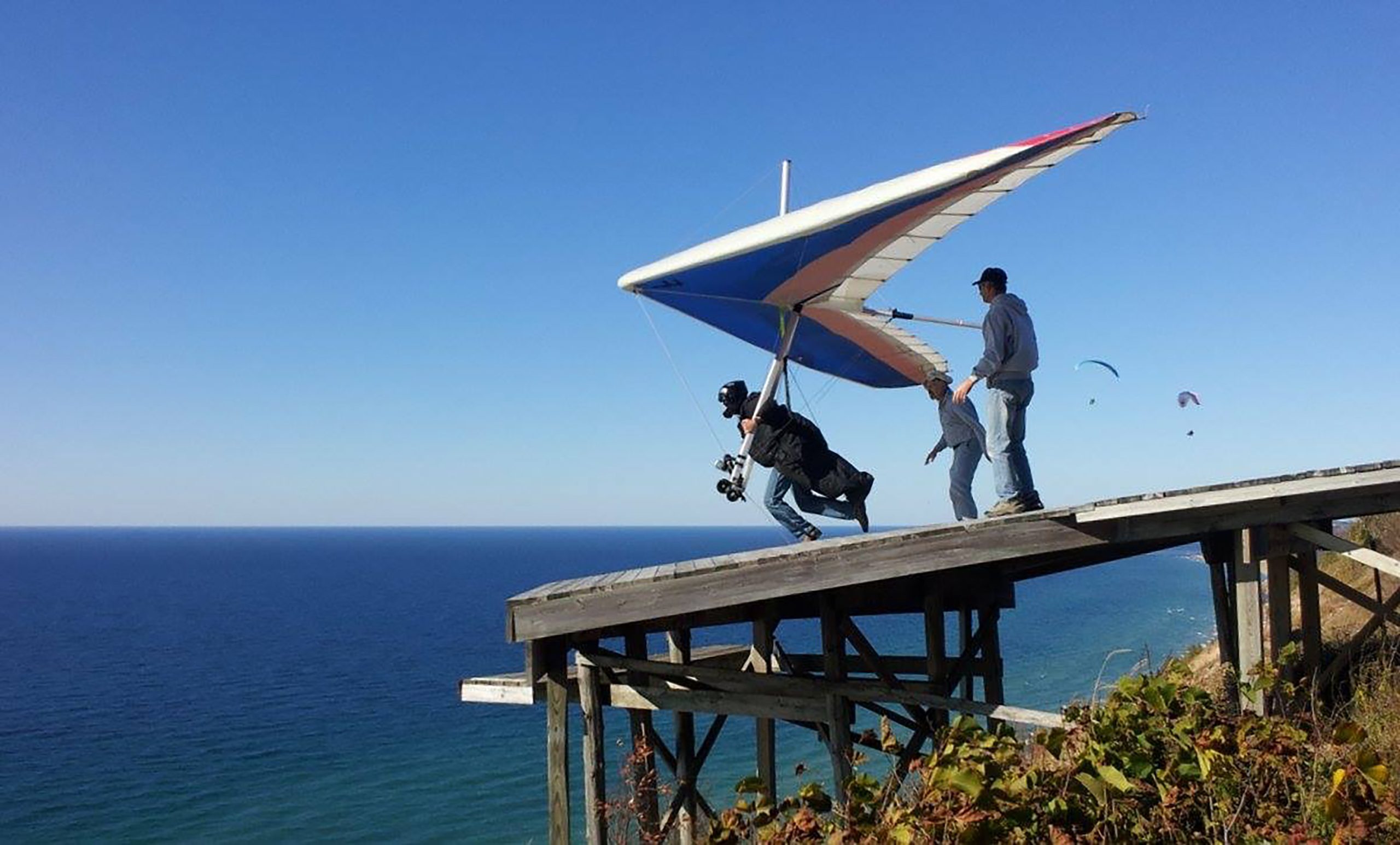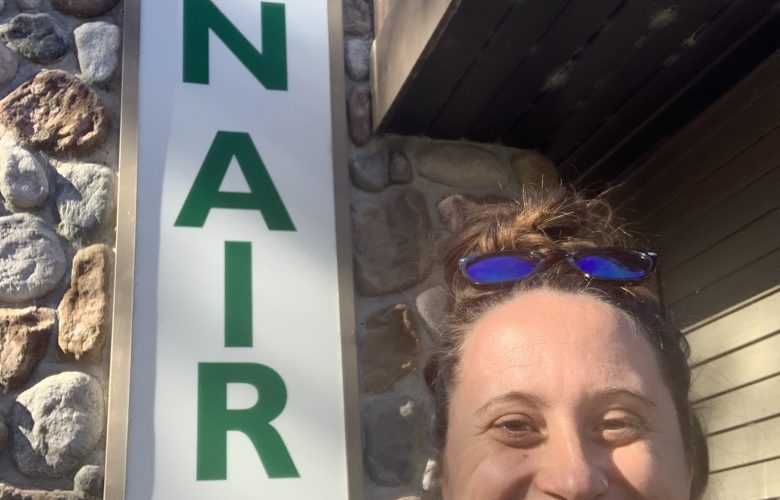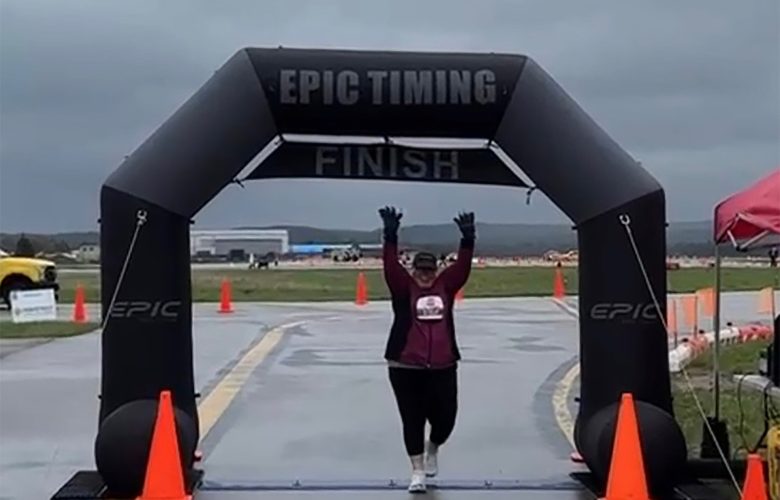Green Point Flyers sustain local tradition of motorless flight
By Bree McGregor
Current Contributor
Will you jump?
The question weighs heavily on your mind as you and a two-person launch crew haul your 70-pound glider up 30 wooden steps, cut steeply into the backside of a grassy bluff. Awaiting you at the top is the Green Point Flyers’ launch platform. Built in the 1970s for launching hang gliders—and meticulously maintained by its present-day owners—the launch juts dramatically from a 340-foot sandy bluff.
The wide and gently sloping wooden platform offers stunning views of Lake Michigan—and no guard rails. Suddenly, the cumulus clouds dotting the blue sky seem nearly eye level.
Is your heart racing from the climb, or is it the “leap of faith” that awaits?
Beneath a warm sun, fully inflated windsocks whip in the 20-mile-per-hour west wind, indicating ideal soaring conditions. Grabbing the front cables and side wires, the launch crew wrangles your glider, as it bucks the headwind and fights to take flight.
It is time to hook in.
You hook into the glider’s main—and back-up—hang straps and lock the carabiner gate. Then, you lie down for a “hang check” and perform a mental checklist to ensure that you and your equipment are properly aligned. You take a few deep, calming breaths to clear your mind. Then you stand up and slide your hands down the uprights, so that your arms are mostly straight and your hands are below your waist. Ahead, the endless horizon beckons.
It is time to launch.
You yell, “Clear!” and the crew drops the side wires, as you attempt a running launch from the platform—but the glider has other plans and rises vertically with such speed that your running feet never touch the ground.
You are airborne.
It is a dizzying ascent that feels wildly exhilarating, yet within your control, as you circle upward hundreds or even thousands of feet over Lake Michigan, silently soaring with birds of prey who have hunted from these skies for millennia.
You climb and climb until you reach the cloud base, and then you glide—surveying miles of dense green hills, serpentine stretches of sandy beach, and the endless glittering expanse of Lake Michigan beneath you.
History of Gliders
After 50 years of soaring, local resident and Green Point Flying Association (GPFA) member Dave Embertson (65) still experiences an intense rush of emotions with each launch.
“When my feet leave the ground,” he says, “there is no way to describe the many feelings… knowing that there are very few in this world who are privileged to experience foot-launched, silent flight. That I get to do this! Grateful. Blessed. Spiritual!”
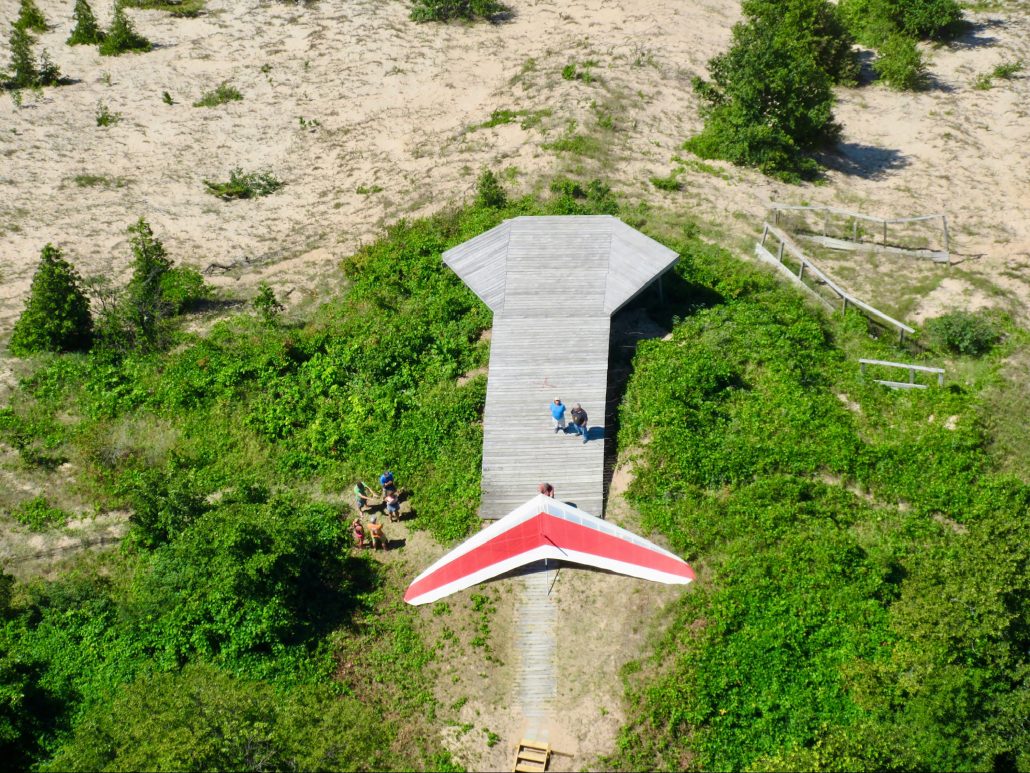
Current GPFA president Craig Carlson (69), a 44-year veteran of the sport, echoes Embertson’s sentiments:
“The feeling I get when I launch is total freedom, to be able to fly like a bird. Your troubles go away, and the only thing going through your mind is the beauty of your surroundings.”
Northern Michigan has a rich soaring history dating back to the early 20th century, and Sleeping Bear Dunes National Lakeshore is home to some of the best soaring terrain in the country.
Authors Peter R. Sandman and Jeffery P. Sandman, a Frankfort-based father-and-son team, compiled a stunning and comprehensive pictorial history of motorless flight in Soaring and Gliding the Sleeping Bear Dunes National Lakeshore Area, a book published in 2006.
The authors trace Michigan’s soaring origins to October 17, 1909, when Edwin Elton Smith of Traverse City soared for 600 feet at an altitude of 50 feet near the Sleeping Bear Dunes area. Smith used a glider that had been built by Charles Augustine on a farm near Arbutus Lake.*
Two decades later, flights were documented in Ludington and South Haven. By the early 1930s, the Detroit-based American Business Club (A.B.C.) Glider Group was making weekly pilgrimages to Sleeping Bear Dunes, as the site provided ideal air currents for hours-long flights, steeply sloping multi-directional dunes of sufficient length for winch-launched takeoffs, and miles-long stretches of beach for landing, where aircraft could be towed by a Model A Ford roadster sporting 9-by-13-inch donut tires.
Before the end of the decade, the recreational sport of soaring and gliding was firmly entrenched in nearby Frankfort. A local soaring club was formed, national soaring meets took place, a soaring school opened its doors, and a sailplane factory was established on Main Street, ultimately building the U.S. Army‘s first military training glider during World War II.
Frankfort had caught “soaring fever.”
Sandman and Sandman explained:
“When a Frankfort businessman was late for dinner, his wife only shrugged and said, ‘Must be a good soaring day.’ The truant officer had learned to make a daily scrutiny of the glider field.”
With support from the Frankfort Rotary Club, the first soaring group—the Frankfort Glider Club—formed in the summer of 1938. The club flew year round, even utilizing the frozen Crystal Lake and Betsie Bay for landings during the winters.
According to Sandman and Sandman, founding members included George Dayton Hardy, who worked on car ferries; J.J. “Jim” Smiley, who ran a lumber and coal yard; Dr. Fred Thacker; and Ralph Dixon, who owned the dry cleaner. Most of the Frankfort Glider Club members were also Frankfort Rotarians.
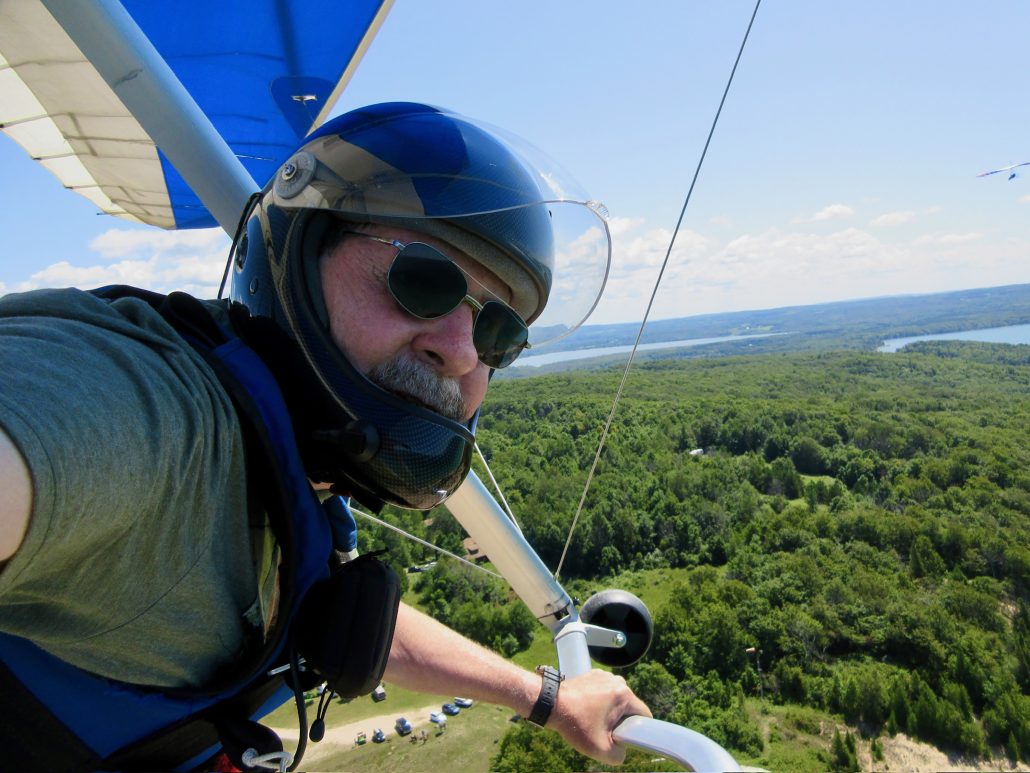
In 1938, the first annual American Open Soaring Meet was held in the Frankfort-Elberta area, drawing soaring legends from across the country. The events held a festive atmosphere and a warm sense of community.
According to Sandman and Sandman, “[Frankfort] had come up with $1,500 [more than $33,000 in today’s economy] in prize money for the event, which also featured a fish bake, a dance, and a beach party—all staples of future soaring meets held in the area.” The authors reported that 222.5 pounds of fish were broiled outside of Davis Bakery by commercial fisherman Ole Olsen, and 175 people were served for a charge of $1 each.
By the time that the second annual American Open Soaring Meet began, according to Sandman and Sandman, Frankfort had received national publicity in National Geographic, Life, The Rotarian, The Saturday Evening Post, and even the front page of The New York Times.
These weeklong meets drew approximately 30,000 people each year, and crowds of spectators packed the beaches and hills to enjoy the show, free of charge. There was no shortage of entertainment, and the authors noted that pilots who landed in Lake Michigan were “given a vial of [lake] water at the awards ceremony and proclaimed to be members of the Dunker’s Club.”
The American Open Soaring Meets drew some of the greatest pilots from around the world who set new soaring records here. To name a few: Helen Montgomery of Detroit set the women’s world duration record of seven hours and 22 minutes aloft in 1938; L.D. Montgomery set the longest cross-country flight of 32.5 miles at an altitude of 6,790 feet in 1939; and Ted Bellak set a world record 57-mile flight across Lake Michigan from Sturgeon Bay, Wisconsin, to Frankfort in 1939.
Around this time, a local businessman persuaded pilots Bellak and Stan Corcoran to create The Frankfort Sailplane Company and The Frankfort School of Soaring.
Upon opening its doors in 1939, the Frankfort School of Soaring was enrolled to capacity and had a waiting list of prospective students. According to Sandman and Sandman, “It was modeled somewhat on the system under which several hundred-thousand German youths had been taught the rudiments of flight.”
Many licensed glider pilots who trained at The Frankfort School of Soaring later became flight instructors in the Army Air Corps in Texas, and Bellak eventually joined the U.S. Navy as a pilot and flight instructor during World War II.
The Frankfort Sailplane Company—formerly located on the corner of Fourth Street and Main Street, where there is now a commemorative sign—was said to be one of the three largest U.S. sailplane manufacturing companies of its time, according to Sandman and Sandman. During World War II, military gliders were used to deliver combat troops and equipment deep into enemy territory. At the onset of the war, the Frankfort Sailplane Company received government contracts to build training gliders, and the company was subsequently moved to Illinois.
According to Smithsonian National Air and Space Museum records:
“On May 26, 1941, the Frankfort Sailplane Company received a $5,784 contract [nearly $126,000 in today’s economy] from the AAF for three prototypes of a two-place glider designated XTG-1. This was the first contract issued for a U. S. training glider. The new design, soon to be called the Cinema II or Corcoran Model B, consisted of an additional tandem seat in a stretched cockpit. Other changes included a fixed horizontal stabilizer and elevator in place of the all-moving stabilizer on the Cinema I. Stall speed was only 59 km/h (36 mph) and the never-exceed speed was calculated at 130 km/h (80 mph).”
After the war, soaring activity slowly resumed in the Frankfort-Elberta area and peaked in the 1970s, with an annual festival organized to honor those who had pioneered the sport in Northern Michigan, many of whom returned for the event.
Around this time, hang glider pilots began launching from the bluffs south of Elberta and conducting meets. (It was not until the early 2000s that paragliders were launching, as well.**)
The First National Glider Festival took place in the Frankfort-Elberta area during July 1973, and according to Sandman and Sandman, “By the next year, steps made of used tires and a launch platform were built [at Elberta beach] for the 1974 meet that attracted nearly 200 kite pilots.”
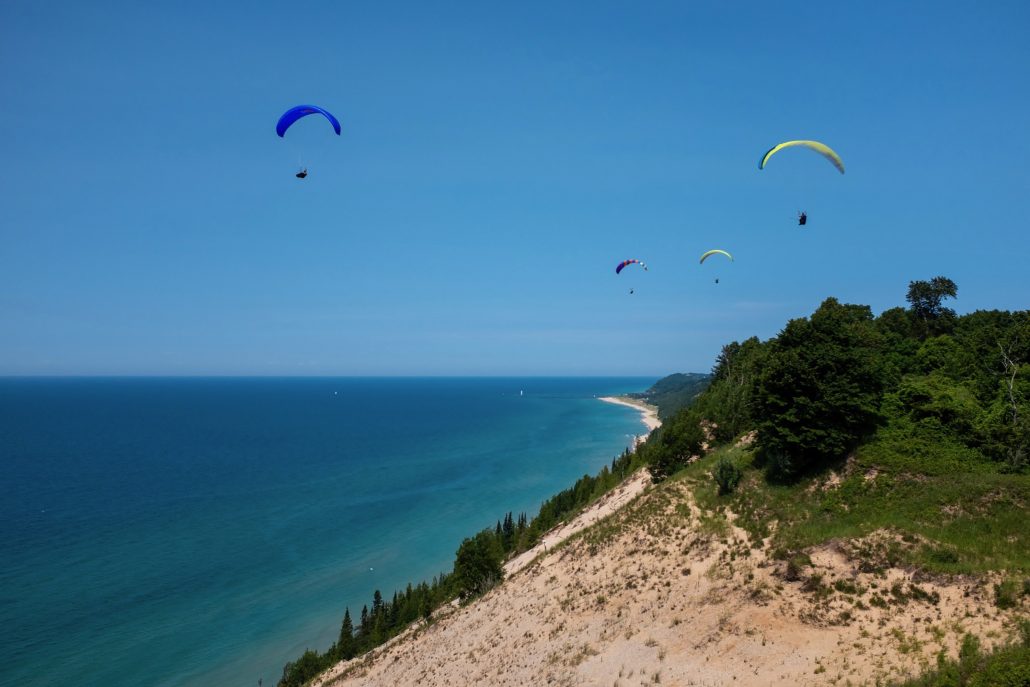
GPFA member Embertson recalls helping to dig and install the stairs—a portion of which can still be found today at Elberta beach—when he was a young man.
Green Point Flyers Association
Given the Frankfort-Elberta area’s long and fabled history in the sky, the GPFA started out as a group of hang glider pilots in the 1970s who were looking for a launch site that they could preserve into the future. The group ultimately purchased 10 acres of waterfront bluff about 340 feet above Lake Michigan.
“Fifty pilots chipped in and purchased the land and formed the group Green Point Flyers Association,” Carlson explains.
Embertson adds that the property was discovered by chance:
“[The flyers] launched by Elberta and flew the two-mile ridge and discovered the 10 acres for sale at the highest point of the ridge.” After buying the property, Embertson explains, “They built the launch ramp with pine logs and boards and created the launch.”
More than 50 years later, GPFA members are still launching from that site year round—weather permitting, of course—and two of its founding members, Mike Stimac, of Traverse City, and Wayne Bergman, of Norton Shores, still fly.
According to Embertson, GPFA has also partnered with Sleeping Bear Dunes National Lakeshore for more than 40 years to launch and fly from three sites within park boundaries: Sleeping Bear, Empire, and Pyramid Point.
GPFA has been a chapter of the national organization, the United States Hang Gliding and Paragliding Association (USHPA), for more than 40 years. (Notably, there are about 100 chapters of the USHPA around the country with around 8,500 members total, as of 2020 statistics.) The GPFA holds an annual meeting and manages maintenance and upgrades through owner workbees; the GPFA is a private property and currently has 36 owners, 14 of whome are active pilots.
“We do allow non-owners to use the property for launching, if they are current members of the USHPA and have the ratings and experience needed to fly safely,” Carlson says. Of the estimated 60 to 65 non-owner members, two are women: paraglider pilots Lynn Gras, of Manistee, and Kallie Spidahl of Traverse City.
The GPFA is a formed corporation, and they are managed by a board of directors that are elected by the owners every two years. In addition to Carlson, who is the current president, and Embertson, who is the safety director, Bill Fifer serves as vice president, and James Jenks serves as secretary. Carlson estimates GPFA members’ median age at 65.
“Because of insurance restrictions, we haven’t been able to train hang gliding or paraglider students, and so that slows the influx of younger, new pilots,” Carlson says.
However, Carlson and Embertson were both hooked on flying at a young age.
“I started flying hang gliders at age 14, in 1974, and I took lessons in Missoula, Montana, when the sport was in its infancy,” Embertson recalls. “I [had] read an article in 1972 in Popular Mechanics with incredible pictures of two California teen guys jumping off beach cliffs near [Los Angeles], hanging on bamboo-and-plastic hang gliders by their armpits. I was hooked; I had to do that! I went through another school in 1978 in Denver, Colorado. I joined GPFA in 1979, soon after I moved [to Frankfort] from Minnesota.”
Embertson continues:
“[I] found out later that those two guys in Popular Mechanics were Bob and Chris Wills, hang gliding pioneers and founders of the now well-known ‘Wills Wing’ hang glider manufacturer. Many of us [now] fly with Wills Wing hang gliders.”
Carlson recalls his earliest soaring experience in 1980, when his friend Scot Maue returned from Arizona after discovering the sport and deciding to mentor Carlson in it.
“What really hooked me on the idea of flying was when [Maue] loaned me his harness and glider, and we went to the local training hill, which was a small dune near the Point Betsie Lighthouse,” Carlson says. “Once my feet left the ground and I realized it was controllable, the hook was set—since that day, all my other hobbies fell to the wayside.”
Mechanics and Seasons
Members of GPFA fly with a variety of foot-launching aircraft, meaning that the fliers take a “running leap” and do not require a tow plane or mechanical winch to launch. Aircraft flown by GPFA members include hang gliders, paragliders, powered paragliders (meaning there is a small engine), and even speed wings (which are small, fast paragliders).
Embertson has been flying hang gliders for 50 years and paragliders for four years. He explains the differences between the commonly used aircraft, hang gliders and paragliders:
“[A hang glider consists] of an aircraft aluminum frame, stainless steel cables, aircraft bolts and joiners, with a fabric airfoil stretched over it. With this type of aircraft, the pilot is suspended from a well-built strong harness below and [s/he] controls flight by body movement and weight shift. Hang gliders typically fly at speeds of 15 to 50 miles per hour.”
The paraglider differs in design. Embertson says it is a “lightweight, ram-air canopy with no rigid frame. The canopy is made of fabric cells with openings at the front that inflate when the paraglider moves through the air. The pilot sits in a harness or pod, suspended 15 to 25 feet below the canopy by very strong lines and risers. Fabric handles are attached by lines from the harness to the glider and are called ‘brakes’ These brakes provide speed and directional control by pulling down and distorting either side of the trailing back edge of the glider. Paragliders typically fly at speeds of 15 to 25 miles per hour.”
Both hang gliders and paragliders fly on different kinds of vertical air currents, Embertson says, “such as ‘ridge lift’ or air deflected upwards by land formations, such as ridges, bluffs, or even mountains. Pilots also seek out ‘thermals,’ which are columns or masses of rising air, created by the sun heating the ground.”
If you have enjoyed an afternoon on Elberta beach, you may have seen a GPFA member gliding overhead or even landing near the beach. After soaring for about one to two hours, flyers aim for a designated landing zone (LZ) on a grass-covered plateau near Elberta beach. Embertson explains there is “a lot of room on this plateau to land safely.” Otherwise, he says flyers aim for an alternative LZ on the beach near Grace Road.
Embertson adds:
“When [flyers are] not able to make it to either of these locations, any beach area along the coast of Lake Michigan is a landing place.”
The GPFA members fly year round, though flights are admittedly shorter during the coldest months of winter.
“We generally consider Labor Day weekend as the ‘kickoff’ of our flying season,” Carlson says. “We are a bluff-soaring site, meaning our elevated bluff launch uses the wind that is deflected upward to keep us in the air. Simply put, we are powered by gravity and don’t need to have wind to fly.”
He continues:
“If, for instance, we launch off our ramp and there is no wind, we just glide to the beach and don’t go very far. We call that a ‘sled ride.’ If there is a stronger wind that hits the bluff and is deflected upward faster than we normally glide down, we are able to stay aloft. The stronger the wind, the higher we can soar above the bluff.”
Carlson adds:
“There are also other factors, like thermal activity, that help conditions. There are limitations to what our gliders can handle in terms of speed, and that’s where our risk assessments come in, to guide our pilots to know when to fly and when to stay on the ground. There’s an old saying ‘I’d rather be on the ground and wishing I was in the air than in the air and wishing I was on the ground.’”
Whether GPFA members are launching hang gliders, paragliders, powered paragliders, or speed wings, Embertson says, “All pilots wear helmets, gloves, electronic altimeters, variometers [which measure lift], a reserve parachute in their harnesses for emergencies, and good clothing and boots.” The weather along Lake Michigan can change quickly, and pilots must be prepared.
“Sometimes, turbulence or unstable air or high winds gave [me] reason for pause,” Embertson says. “Trusting in my skills and the equipment triumphs! Staying calm and having a presence of mind works well. The air is not a tamable foe!”
Carlson adds:
“I have had flights where the wind has picked up and made for a turbulent flight, and [I was] wishing I was on the ground. You must be prepared to get on the ground quickly, if you need to. Always have a back-up plan.”
If GPFA members are hooked on thrill-seeking, then they are equally fixated on safety. These pilots hone the balance of passion and caution.
“We are constantly assessing weather and wind conditions and watching the local birds that are good indicators of good flying conditions,” Carlson explains. “White caps and wind lines on the water are good indicators of velocity and direction. Low cloud cover could indicate visibility issues. If conditions change and the safety factor is compromised, you have to be able to walk away from the launch with as much enthusiasm as you started with.”
He adds:
“The highest priority we can have for continuing our existence into the future as a flying site is safety. [The board of directors] constantly monitor our safety standards and have risk assessments that address all aspects of flying, from our physical launch ramp to the hazards that could exist in the landing areas. Risk assessments would also include wind conditions that would be tailored to the skill levels of the pilots.”
With proper training and attention to safety, risk is minimized and epic flights become possible. In one of his most memorable flights during an air show at the Mt. Pleasant Airport, Carlson recalls:
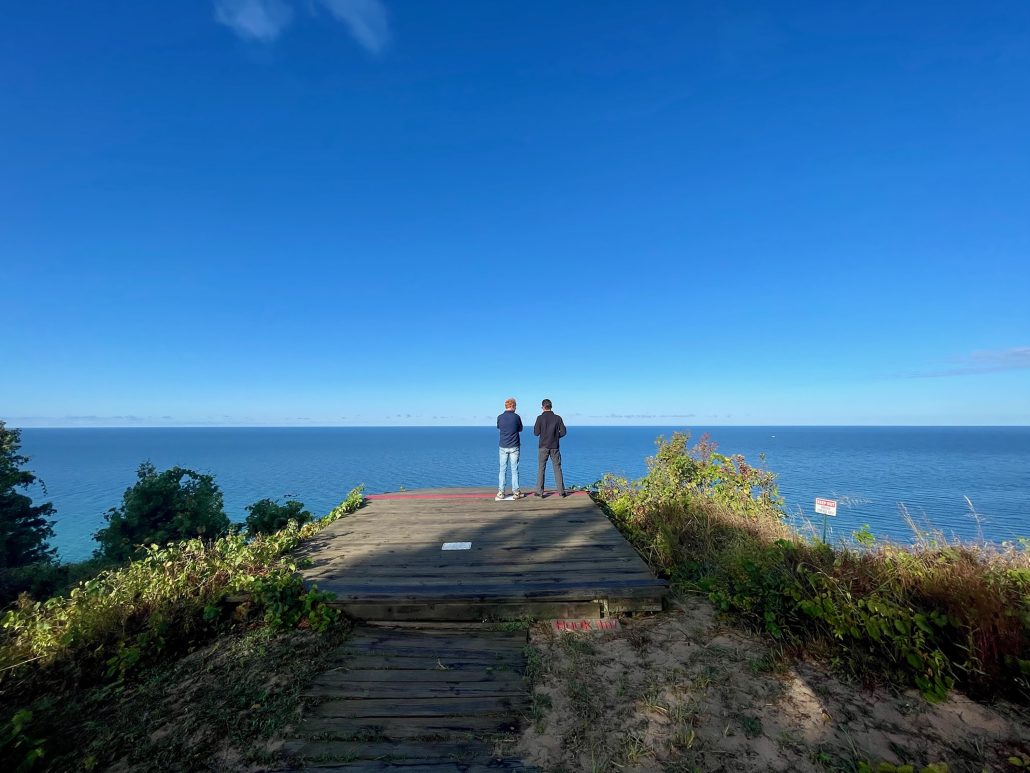
“I released from a tow launch behind a car and flew 59 miles toward Flint and averaged 7,000 feet above the ground. I used a CB [citizens band] radio to direct my wife, Nancy, to where I was going, and she was there to pick me up when I landed.”
If you dream of soaring thermals and casting your shadow far above Lake Michigan’s shoreline, you will first need formal flight instruction from a reputable school with certified USHPA instructors, and then a current USHPA pilot rating. Because of the considerable time and financial cost involved, Embertson strongly suggests first trying a “discovery tandem flight” with an instructor.
After all, bending the laws of nature to your will and soaring thousands of feet above the earth is not for the faint of heart. You will need to be certain that—once you have climbed the steps to the launch platform and it is time to hook in to take flight—the answer to the question Will you jump? is given with confidence and with expertise.
You can view Stan Corcoran’s TG-1A (Training Glider Model 1A) at the Steven F. Udvar-Hazy Center in Chantilly, Virginia, as part of the World War II Aviation Exhibit, National Air and Space Museum Collection. Learn more at AirAndSpace.si.edu/visit/udvar-hazy-center online.
Soaring and Gliding the Sleeping Bear Dunes National Lakeshore Area by Jeffery P. Sandman and Peter R. Sandman is available for purchase at The Bookstore of Frankfort or a copy may be reserved at the Benzie Shores District Library in Frankfort.
A special thanks to GPFA president Craig Carlson and safety director Dave Embertson, who generously shared their photos, expertise, and passion for the sport. Email Craig.GPFA@gmail.com to learn more or get involved.
*Notably, Albrecht Ludwig Berblinger (1770-1829) had drafted a design for the first hang glider nearly a century earlier, in the early 1810s, in Germany, though further technical and scientific advancements were needed before the first practical gliders began to be built and used in the 1880s. (Berblinger survived a crash into the Danube River in 1811, and though he was not the first man in flight, he is remembered as a pioneer in aviation, leading to glide flights by Otto Lilienthal in 1891 and the Wright Brothers in 1902.)
**“Hang gliders typically weigh more than 50 pounds, can be carried balanced on your shoulder, and require a roof rack to transport on a vehicle; paragliders and speedwings typically weigh less than 50 pounds, are carried in a backpack, and can fit inside a vehicle,” according to the U.S. Hang Gliding & Paragliding Association (USHPA).
Featured Photo Caption: Chris Christophersen launches a Wills Wing U2 from the Green Point Flyers Association property, just south of Elberta, with help from Carl Lipson and Angelo Mantas. Paragliders can be seen in the distance. Photo courtesy of Wayne Bergman.

